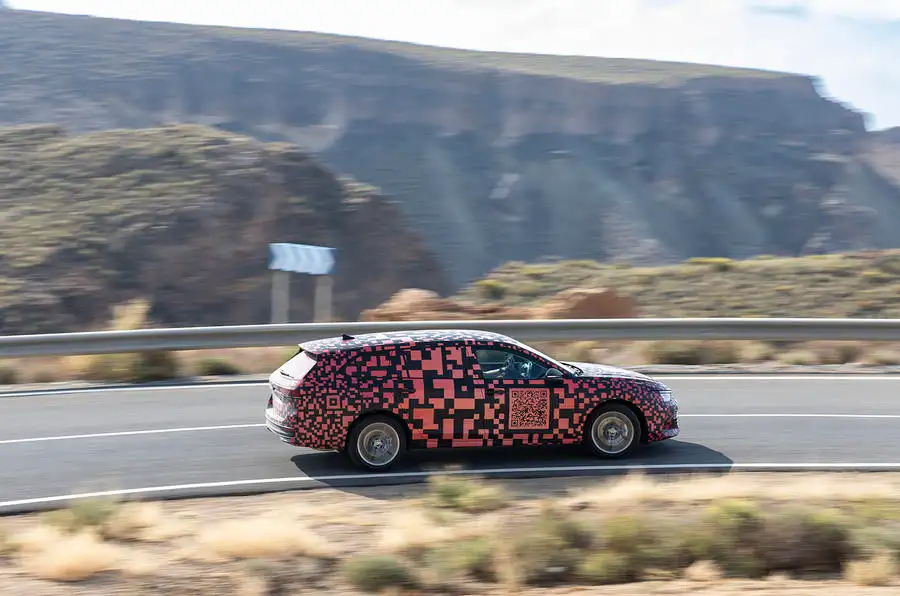Sensible Passat wagon from Volkswagen takes a step up in both size and plushness for its ninth generation.
In a world increasingly preoccupied with electric cars, it can be easy to lose sight of the fact that internal-combustion-engine models such as the Volkswagen Passat continue to do the biggest business across the globe.
For this reason, VW has decided to extend the life of the Passat into a ninth generation despite the impending introduction of an electric-powered alternative in the form of the new Volkswagen ID 7.
The two-pronged approach mirrors that of other Volkswagen models, including the Golf and ID 3 as well as the Tiguan and ID 4. It is intended to enable the Passat, which joined the Volkswagen line-up in 1973, to build on the 30 million sales it has racked up to date against a backdrop of the German car maker’s multi-billion-pound spend on new electric models.
The Passat prototype driven here on Volkswagen’s Ehra-Lessien test track and surrounding roads is among a fleet of validation mules pressed into action ahead of a planned unveiling for the new car in September.
As part of Volkswagen’s modular approach to manufacturing, it also shares key components with the third-generation Tiguan, including its MQB EVO platform, electric architecture and petrol, diesel and plug-in hybrid drivetrains, providing it with valuable economies of scale with its equally new stablemate.
Despite the Q-code-inspired disguise worn by the prototypes, there is a clear evolutionary approach to the exterior styling. One notable change is the introduction of a blanked-off upper-grille element housing a horizontal light bar. All of the engine bay and front brake cooling is now handled by ducts within the lower part of the front bumper.
Dimensionally, the Passat has grown. Length, width and height are up by 144mm, 20mm and 7mm respectively at 4917mm, 1852mm and 1482mm. The wheelbase has also grown by 50mm to 2841mm, essentially taking it up a class in overall positioning.
Inside, there’s an all-new cabin. The changes here are arguably even more pronounced than with the exterior. They revolve around a new-look dashboard that features a 10.25-inch digital instrument display with up to four different skins and a standard 12.9-inch or optional 15.0-inch infotainment display.
Ahead of the driver is a new flat-bottomed multifunction steering wheel with traditional buttons in place of the fiddly capacitive controls of recent Volkswagen models. The traditional gearlever has also given way to the same steering-column-mounted controller used by the ID Buzz and ID 7, freeing up space on the centre console for larger cupholders and added oddment space as well as a charging pad for smartphones.
The extra length liberates an added 50mm of rear leg room, according to Volkswagen. Boot space has also increased by 40 litres to a nominal 690 litres underneath the luggage cover. With the rear seats folded down, luggage capacity grows by 140 litres over the existing Passat to 1920 litres.
We’ve yet to receive a full rundown of the new Passat’s engines, but Volkswagen brand CEO Thomas Schaefer has confirmed that it will offer a range of updated transversely mounted four-cylinder petrol and diesel engines, selected versions of which will have 48V mild-hybrid tech – all with Euro 7 emission compliance. Engine capacities range from 1.5 through to 2.0 litres, with buyers set to get a choice of either a six-speed manual or seven-speed dual-clutch automatic transmission along with front- or all-wheel drive.
There are also two new petrol-electric plug-in hybrid (PHEV) drivetrains in the works. They use a 1.5-litre four-cylinder petrol engine in combination with a gearbox-mounted electric motor for a system output of 150kW and 197kW respectively. The battery will grow substantially compared with current Volkswagen Group PHEVs. It’ll be around 26kWh, giving an electric range of almost 130km. In addition, they’ll get faster AC charging and DC charging.
To get under way, you hit the start button within the centre console and twist the end of the gear controller to the ‘D’ position.
The changes to the interior, including a new interface and menu structure for the infotainment system, make this Passat an agreeably straightforward car to operate. There’s a higher level of perceived quality, too.
The strongest of the turbocharged 2.0-litre four-cylinder diesel engines provides brisk step-off and in-gear performance, with plenty of low- to mid-range flexibility and relatively refined characteristics.
The seven-speed dual-clutch transmission is quick to react, a feature that combines with the engine’s low-rev flexibility to make the car feel pleasingly long-leggged at motorway cruising speeds. As is typical for a modern DSG, it can be reluctant to grab a lower gear if you ask for more acceleration.
The steering is accurate and nicely weighted, with eager self-centring and greater feedback than before. The changes to the suspension also bring an added degree of agility and improved body control to the handling. All this makes it a sharper and more enjoyable car to drive than its predecessor. It’s easy to place on the road and get along with. Just don’t expect it to be sporting or remotely athletic.
The new Passat benefits greatly from the new twin-valve dampers, which bring added absorption and more controlled rebound properties. The upshot is much smoother progress, even over badly pockmarked roads.
It is still undergoing final development, but our first drive of the new Passat makes it clear that it is already a better car than its popular predecessor. The changes made to the long-running estate ensure that it retains the intrinsic values and everyday practicality that buyers expect and demand.
However, it now offers a more precise driving feel, added handling prowess and vastly improved ride comfort. There’s familiarity in many aspects, but at the same time greater maturity to the dynamics. And with the number of direct internal-combustion-engine competitors steadily declining, there’s something very reassuring about a new Volkswagen Passat.








